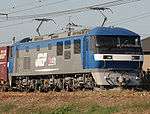Meitetsu DeKi 400
The Meitetsu DeKi 400 (名鉄デキ400形, Meitetsu Deki 400-gata) was a Bo-Bo wheel arrangement electric locomotive type operated by private railway operator Nagoya Railroad (Meitetsu) in Japan.
| Meitetsu DeKi 400 | |||||||||||||||||||||||
|---|---|---|---|---|---|---|---|---|---|---|---|---|---|---|---|---|---|---|---|---|---|---|---|
DeKi 402 in September 2008 | |||||||||||||||||||||||
| |||||||||||||||||||||||
| |||||||||||||||||||||||
| |||||||||||||||||||||||
| |||||||||||||||||||||||
Operations
Originally used to haul freight trains on the eastern end of the Meitetsu Nagoya Main Line and Meitetsu Mikawa Line, they were later used primarily on track maintenance trains and rolling stock transfer duties.[1]
History
The two locomotives were built in 1930 and 1931 for the Aichi Electric Railroad, numbered DeKi 400 and DeKi 401.[2] The locomotive bodies were built by Nippon Sharyo of Japan, and the electrical equipment was built by the American company Westinghouse Electric Company.[2] When the Aichi Electric Railroad was absorbed into Meitetsu, the two locomotives retained their original DeKi 400 classification, but locomotive number DeKi 400 was renumbered DeKi 402.[2]
Originally painted in black, the locomotives were repainted into "Meitetsu Blue" when they underwent life extension refurbishment in 1993.[3] The locomotives were originally fitted with two large Westinghouse pantographs, but these were subsequently replaced by single PT42-F lozenge-type pantographs.[2]
Withdrawal
The DeKi 400 locomotives were withdrawn during fiscal 2015, replaced by new Class EL120 locomotives,[4] and cut up in June 2016.[1]
References
| Wikimedia Commons has media related to Meitetsu Type Deki 400. |
- 私鉄の電気機関車 パーフェクトガイド [Private Railway Electric Locomotives Perfect Guide]. Tetsudo Club (in Japanese). Vol. 2. Japan: Cosmic Publishing. April 2017. p. 133. ISBN 978-4-7747-8338-3.
- Goda, Tsuneo (May 2015). 私鉄・専用線機関車ウォッチング(19) [Private railway and industrial line locomotive watching (19)]. Japan Railfan Magazine (in Japanese). Vol. 55 no. 649. Japan: Koyusha Co., Ltd. pp. 89–92.
- ELダイヤ情報21 [Electric Loco Timetable Information 21] (in Japanese). Tokyo, Japan: Kotsu Shimbunsha. October 2012. p. 61. ISBN 978-4330320120.
- 名古屋鉄道EL120形 [Meitetsu Class EL120]. Japan Railfan Magazine (in Japanese). Vol. 55 no. 649. Japan: Koyusha Co., Ltd. May 2015. pp. 55–57.
